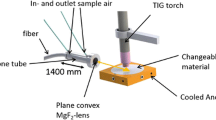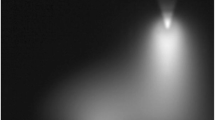Abstract
Arc beads generated from metal conductors by arc discharges have a risk of causing fires when contacting the combustibles. In this work, the process of arc bead generation from conductors due to arc discharge was investigated experimentally. The copper conductors with four different diameters (1.5, 2.5, 4, 6 mm2) were chosen to produce arc beads by the arc discharges with currents from 60 to 220 A. It was observed that the arc bead was generated when its gravity overcame the surface tension between the arc bead and the conductor. The diameter of the arc bead was found to increase with the conductor diameter, and an expression was established to describe this relationship. It was also found that the minimum discharge time required for the arc bead formation was negatively correlated with the discharge current, but positively correlated with the conductor diameter. The findings of this work help assess the ignition risk caused by arc beads







Similar content being viewed by others
References
Lyu H-F, Wang C-P, Deng J, Wang W-F, Li Y, Shu C-M (2023) Arc bead ignition of a cellulose fuel bed derived from experimental and simulated data. Fuel 339:127417. https://doi.org/10.1016/j.fuel.2023.127417
Urban JL, Zak CD, Fernandez-Pello C (2015) Cellulose spot fire ignition by hot metal particles. Proc Combust Inst 35:2707–2714. https://doi.org/10.1016/j.proci.2014.05.081
Wang S, Chen H, Liu N (2015) Ignition of expandable polystyrene foam by a hot particle: an experimental and numerical study. J Hazard Mater 283:536–543. https://doi.org/10.1016/j.jhazmat.2014.09.033
Wang S, Huang X, Chen H, Liu N (2017) Interaction between flaming and smouldering in hot-particle ignition of forest fuels and effects of moisture and wind. Int J Wildland Fire 26:71–81. https://doi.org/10.1071/WF16096
Yang W, Tao Z, Yang R, Gao Z, Wang J (2022) Study on the mechanism of molten aluminum droplets igniting EPS foam. Combust Flame 244:112297. https://doi.org/10.1016/j.combustflame.2022.112297
Yang W, Yang R, Gao Z, Tao Z, Wang J (2023) Effect of impact velocity on molten aluminum and copper droplets igniting expanded polystyrene foam. J Saf Sci Resil 4:9–19. https://doi.org/10.1016/j.jnlssr.2022.09.005
Wang S, Huang X, Chen H, Liu N, Rein G (2015) Ignition of low-density expandable polystyrene foam by a hot particle. Combust Flame 162:4112–4118. https://doi.org/10.1016/j.combustflame.2015.08.017
Fernandez-Pello A, Lautenberger C, Rich D, Zak C, Urban J, Hadden R, Scott S, Fereres S (2015) Spot fire ignition of natural fuel beds by hot metal particles, embers, and sparks. Combust Sci Technol 187:269–295. https://doi.org/10.1080/00102202.2014.973953
Majstrovic M, Sutlovic E, Ramljak I (2017) Critical diameter of particles produced in overhead line conductor clashing. Appl Therm Eng 114:713–718. https://doi.org/10.1016/j.applthermaleng.2016.12.008
Majstrović M, Sutlović E, Ramljak I, Nižetić S (2018) Comparison of aluminum and copper particle critical diameter produced in overhead line conductor clashing. In: Nižetić S and Papadopoulos A (eds) The role of exergy in energy and the environment. pp 13–25 doi:https://doi.org/10.1007/978-3-319-89845-2_2
Sutlovic E, Ramljak I, Majstrovic M (2019) Analysis of conductor clashing experiments. Electr Eng 101:467–476. https://doi.org/10.1007/s00202-019-00790-0
Rallis CJ, Mangaya BM (2002) Ignition of veld grass by hot aluminium particles ejected from clashing overhead transmission lines. Fire Technol 38:81–92. https://doi.org/10.1023/A:1013484932749
Tse SD, Fernandez-Pello AC (1998) On the flight paths of metal particles and embers generated by power lines in high winds—a potential source of wildland fires. Fire Saf J. https://doi.org/10.1016/S0379-7112(97)00050-7
Maranghides A, Mell W (2011) A case study of a community affected by the witch and Guejito fires. Fire Technol 47:379–420. https://doi.org/10.1007/s10694-010-0164-y
Mitchell JW (2013) Power line failures and catastrophic wildfires under extreme weather conditions. Eng Fail Anal 35:726–735. https://doi.org/10.1016/j.engfailanal.2013.07.006
Coldham D, Czerwinski A, Marxsen T (2011) Probability of bushfire ignition from electric arc faults. HRL Technology Pty Ltd, Mulgrave Victoria
Author (2020) 25 held responsible in deaths of 19 from devastating sichuan forest fire. China Daily https://www.chinadaily.com.cn/a/202012/21/WS5fe0aaefa31024ad0ba9d2ba.html
Urban JL, Zak CD, Song J, Fernandez-Pello C (2017) Smoldering spot ignition of natural fuels by a hot metal particle. Proc Combust Inst 36:3211–3218. https://doi.org/10.1016/j.proci.2016.09.014
Mills A (1984) Trajectories of sparks from arcing aluminum power cables. Fire Technol 20:5–14. https://doi.org/10.1007/BF02384146
Song J, Wang S, Chen H (2014) Safety distance for preventing hot particle ignition of building insulation materials. Theor Appl Mech Lett 4:034005. https://doi.org/10.1063/2.1403405
Psarros EG, Polykrati AD, Karagiannopoulos CG, Bourkas PD (2009) A model for calculating the temperature of aluminium particles ejected from overhead low-voltage lines owing to a short-circuit. Int J Wildland Fire 18:722–726. https://doi.org/10.1071/wf08128
Blackburn TR (1985) Conductor clashing characteristics of overhead lines. In: Electric Energy Conference. Newcastle, Australia
Ramljak I, Majstrovi M, Sutlovi E (2014) Statistical analysis of particles of conductor clashing. In: 2014 IEEE International Energy Conference. Cavtat, Croatia
Tian Q (2021) Study on ignition ability and metallographic structure of short circuit splashed bead. Master Thesis. Xi’ an University of Science and Technology
Lyu H-F, Wang C-P, Deng J, Wang W-F, Li Y, Shu C-M (2023) Ignition ability prediction model of biomass fuel by arc beads using logistic regression. J Therm Anal Calorim. https://doi.org/10.1007/s10973-023-12023-5
Zhang H, Qiao Y, Chen H, Liu N, Zhang L, Xie X (2021) Experimental study on flaming ignition of pine needles by simulated lightning discharge. Fire Saf J 120:103029. https://doi.org/10.1016/j.firesaf.2020.103029
Babrauskas V (2017) Electric arc explosions—a review. Fire Saf J 89:7–15. https://doi.org/10.1016/j.firesaf.2017.02.006
He H, Zhang Q, Tu R, Zhao L, Liu J, Zhang Y (2016) Molten thermoplastic dripping behavior induced by flame spread over wire insulation under overload currents. J Hazard Mater 320:628–634. https://doi.org/10.1016/j.jhazmat.2016.07.070
Yildirim OE, Xu Q, Basaran OA (2005) Analysis of the drop weight method. Phys Fluids 17:062107. https://doi.org/10.1063/1.1938227
Taihei M, Hidetoshi F, Takaharu U, Masayoshi K, Kiyoshi N (2005) Surface tension measurement of molten metal using a falling droplet in a short drop tube. Trans JWRI 34:29–33
Acknowledgements
This research was supported by Science and Technology Project of State Grid Corporation of China (Research on the interaction mechanism and risk assessment technology of high voltage power line fault and forest fire, No. 5200-202126099A-0-0-00).
Author information
Authors and Affiliations
Corresponding author
Ethics declarations
Conflict of interest
The authors declare that they have no known competing financial interests or personal relationships that could have appeared to influence the work reported in this paper.
Additional information
Publisher's Note
Springer Nature remains neutral with regard to jurisdictional claims in published maps and institutional affiliations.
Supplementary Information
Below is the link to the electronic supplementary material.
Supplementary file1 (MP4 386 kb)
Rights and permissions
Springer Nature or its licensor (e.g. a society or other partner) holds exclusive rights to this article under a publishing agreement with the author(s) or other rightsholder(s); author self-archiving of the accepted manuscript version of this article is solely governed by the terms of such publishing agreement and applicable law.
About this article
Cite this article
Zhang, H., Guo, P., Chen, H. et al. Experimental Study on the Generation of Arc Beads from Conductors by Arc Discharge. Fire Technol 60, 273–287 (2024). https://doi.org/10.1007/s10694-023-01502-8
Received:
Accepted:
Published:
Issue Date:
DOI: https://doi.org/10.1007/s10694-023-01502-8




